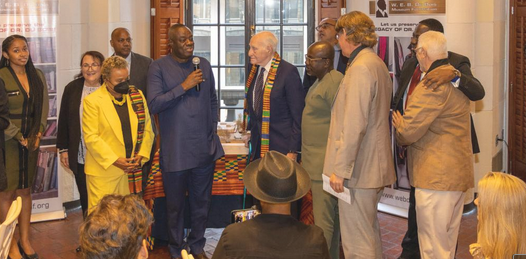Photos: W.E.B. Du Bois Museum Foundation
NEW YORK, NY — September 19, 2022 — The W. E. B. Du Bois Museum Foundation Sunday unveiled plans and renderings for the new W. E. B. Du Bois Museum Complex in Accra, Ghana, designed by Sir David Adjaye, the internationally acclaimed architect of the Smithsonian Museum of African American History and Culture. The expansion, transformation, and repositioning of the Du Bois Centre in Ghana will turn into a dramatic global center for tourism, study, and celebration of the Pan African diaspora and will bring to a new generation the vision and writings of W. E. B. Du Bois, the most important African American intellectual of the 20th century. It will serve as the starting point for visitors returning to Africa to explore their roots, and include a scholastic institute, library, outdoor auditorium, memorial pavilion, craft shops for artisans, a café, and large open spaces for formal gatherings and lectures.
“Redeveloping and restoring this historic center is crucial in preserving the legacy of the father of Pan-Africanism so that generations to come can see how his work contributed to American History”, said the Chairman of the W. E. B Du Bois Foundation, Daniel Rose. “It has been my mission to honor Dr. Du Bois and his family. My hope is that this center will be a mecca for intellectual thought and excellence; and a catalyst in bridging our communities across the diaspora together.”
William Edward Burghardt Du Bois virtually invented modern African American letters and inspired the work of practically all other modern African American intellectuals to follow. More than that, he reshaped how the complex experience of America and African America could be understood. He left Americans—Black and white—a legacy of intellectual tools, a language with which they might analyze their present and imagine a future. He played a key role in developing the strategy and program that dominated early 20th-century Black protest in America and was one of the founders of the NAACP. Du Bois’ collection of essays, The Souls of Black Folk, is a seminal work in African American literature and a founding work in the literature of Black protest. In it, he eloquently affirmed that it is beneath the dignity of a human being to beg for those rights that belong inherently to all mankind.
“The expansion of this museum is a pivotal moment in American and Ghanaian history. Seeing my great grandfather honored in this way, knowing his legacy and work will continue to have an impact on the lives of so many now and in the years to come is truly a special moment for me and my family”, said Jeffrey Peck, great grandson of W. E. B Du Bois.
Kwame Nkrumah, then President of Ghana, invited Dr. Du Bois to move to Ghana to undertake an ‘Encyclopedia Africana’, an interdisciplinary global publication to document the experience and historical contributions of African peoples in the world, where he died on August 27, 1963—the day before his American compatriots assembled for the March on Washington. The Du Bois Centre is the burial place of both Du Bois and his wife Shirley Graham Du Bois, also a prolific American award-winning author, playwright, composer, and activist for African American and Chinese causes. As part of the renovation the museum will be transformed, repositioned, and expanded while keeping the current structures, the Bungalow and the Gazebo Mausoleum, which will be incorporated into the new W.E.B and Shirley Du Bois Memorial Pavilion. The Bungalow will be restored, as closely as possible, to its original state. A separate Museum and Library will be built to house the books, journals, papers, and other written and visual collections of the Du Bois family. The complex will be completed and dedicated by 2025.
Plans and three-dimensional renderings of the new complex were unveiled by NYC Mayor Eric Adams, US Ambassador to the UN Linda Greenfield, and Ghana Tourism Minister Dr. Ibrahim Mohammed Awal, who joined American business leader and philanthropist Daniel Rose, Founder and Chairman of the W. E. B. Du Bois Museum Foundation, and the great grandchildren of W.E.B Dubois, Jeffrey Peck and Arthur McFarlane II.
The W.E.B Du Bois Museum Foundation is a New York-based non-profit organization established in 2019, with the exclusive mission of honoring the life, purpose, and legacy of the celebrated father of Pan-Africanism, Dr. W. E. B Du Bois, by redeveloping and rebranding his final resting place in Accra, Ghana. The interest and dedication of the Foundation is to revive the current Du Bois Memorial Centre into a Museum Complex and as a destination for scholars, artists, and heritage tourists alike.
The complex will consist of these core facilities:
(1) W.E.B and Shirley Du Bois Memorial Pavilion: The W.E.B. and Shirley Du Bois Memorial Pavilion will be the heart of the complex and the most solemn, revered, and dignified place to visit for contemplation. It will incorporate the current gazebo tomb/shrine that holds the mortal remains of Dr. Du Bois and his wife.
(2) The Du Bois Bungalow: The refurbished and restored bungalow where W. E. B. Du Bois lived, worked, and died with his wife will have flooring, windows, furniture, and fixtures restored to their original states.
(3) Institute Building: This is the largest building in the complex, which features a fully curated Museum/Gallery; the library/research/reading room and administrative offices.
(4) The Museum/Gallery: This will exhibit historical pictures, mementos (University Gown/Robs/Hoods), gifts and other items belonging to Dr. Du Bois and his wife Shirley Graham.
(5) The Library: This will be another important feature of the Complex containing books, periodicals, journals, papers, and publications by and about Dr. Du Bois and his wife Shirley Graham Du Bois, as well as the Pan African movement. It will include a rare books room for the delicate and personal books and papers of Dr. Du Bois and Shirley Graham.
(6) Outdoor Auditorium: This will be used for cultural and artistic performances, informal and formal gatherings, conferences, lectures, shows and special events.
(7) Marcus Garvey Guest House: The Marcus Garvey guest house will be renovated with new roofing, flooring, furnishing, and fixtures to accommodate visiting scholars, visitors, and special guests of the museum.












